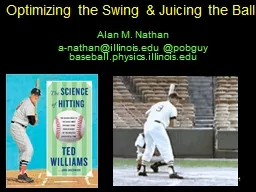

Alan M Nathan anathanillinoisedu pobguy baseballphysicsillinoisedu 2 Is The Baseball Juiced Why the current interest What does juicing mean What do the data tell us ID: 527572
Download Presentation The PPT/PDF document "1 Is The Baseball Juiced?" is the property of its rightful owner. Permission is granted to download and print the materials on this web site for personal, non-commercial use only, and to display it on your personal computer provided you do not modify the materials and that you retain all copyright notices contained in the materials. By downloading content from our website, you accept the terms of this agreement.
Slide1
1
Is The Baseball Juiced?
Alan M. Nathan a-nathan@illinois.edu @pobguy baseball.physics.illinois.eduSlide2
2
Is The Baseball Juiced?
Why the current interest?What does “juicing” mean?What do the data tell us?Summary/conclusions Slide3
1. Why the current interest?3
Boston Herald
ESPNSlide4
1. Why the current interest?(see The Hardball Times, 7/18/16) 24% increase in HR….WHY???4Slide5
2. What does “juicing” mean? Coefficient of Restitution5“bounciness” of ballDrop ball onto hard surfaceCOR=
Fire ball at hard surface
COR=final speed/initial speed Slide6
MLB SpecificationsFire ball from air cannon at 58 mph onto ash boardCOR has to fall in the range 0.514-0.5786Slide7
7Slide8
Data From Sports Science Laboratory, WSUMLB “spec” is “yuge”11% spread at 58 mphExtrapolates to ~6.5 mph spread in exit speed for typical MLB impacts (~160 mph)Test speed matters!Balls that perform identically at low speed do not necessarily do so at high speed83 balls testedSlide9
Higher speedmore sensitive to interior of ball9Slide10
Data from Sports Science Laboratory, WSU2004 baseballs more tightly bunched than 1970’s baseballsError bar ~0.003(~0.4 mph exit speed)10Slide11
Effect of COR on Exit Speed(a brief technical aside) (COR)*(impact speed)/(1+r) r = “bat recoil factor”—weight, etc.
~0.25 for “typical MLB bat” Impact speed =
vpitch+ vswing For COR=0.45, 85+77exit speed = 103 mph Result: Changing COR by 0.01 (2.2%) changes exit speed by 1.3 mphSame result if (vpitch) = 8 mph or (vswing) = 1 mph
11Slide12
MLB Ball TestingDone by Baseball Research Center at UMass/LowellNothing known publiclySample size?Impact speed?# impacts/ballAllowable limits on mean, variance?Year-to-year variation12Slide13
This was big issue in 200013Slide14
14
Deep Dive into Recent DataSlide15
15Slide16
16
A 1.5 mph increase in exit speed accounts for most of increase in HR
Is this evidence for juiced ball?Change in COR by 0.012Slide17
1750 bucketsSlide18
18250-30000-100Slide19
Some RemarksThe exit speed data for typical HR launch angles are consistent with increase in CORThe exit speed for line drives are not“If it doesn’t fit, you must acquit.”We have a definite puzzlePerhaps Brian Mills will solve it in the next talk19